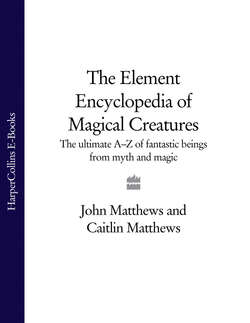Читать книгу The Element Encyclopedia of Magical Creatures: The Ultimate A–Z of Fantastic Beings from Myth and Magic - John Matthews - Страница 258
BOAR
ОглавлениеThe wild boar is a most ferocious and dangerous animal, standing 4 ft at the shoulder, with curling tusks that can break legs and tear open entrails. Throughout the world, this wild pig has been granted a special place among animals of power. Common themes in myths associated with the boar include the pursuit of the end to tyranny, the test of great courage, the elimination of evil customs, the overthrow of old cycles and the gaining of valour.
In Melanesia, the tusks of the boar are the proper adornments of chieftains and elders. They are seen as representing the crescent moon and the continuance of life after death. In Vedic and Hindu tradition, there are many boars. Ruda is the boar of the sky, while Varahi is one of the many forms that Vishnu takes when he saves the Earth from the chaotic waters; he also is the first one to plough the soil. Vajnavrahi is the goddess of the dawn in the form of a sow who is the source of all life.
Among the Celts, the meat of the boar furnished ‘the hero’s portion’ – the joint of meat that could only be awarded to the most valorous. Many stories relate how quarrels arose from disputes over its apportioning.
The trouble-making Irish satirist, Bricrui, calls the Ulster heroes to a feast at his house. At the distribution of the hero’s portion, three heroes rise up to claim it. The story relates how otherworldly challenges were placed upon the claimants in order that they might be eliminated one by one. Cu Chulainn is the clear winner, having submitted to a beheading game from which the other claimants slink away. Having beheaded a mysterious grey giant, Cu Chulainn learns he must surrender his own head in return. Before the axe falls upon the hero’s neck, the grey giant wielding it resumes his customary form as the clever chieftain, Cu Roi mac Daire and acclaims Cu Chulainn as the rightful winner of the now cold hero’s portion.
King Arthur and his nephew, the Welsh hero Culhwch, seek the ravening boar, Twrch Trwyth because it carries talismans of great magical strength. With warriors from Arthur’s court and the assistance of otherworldly heroes, Culhwch pursues the huge creature across half of Britain in search of the magical comb and scissors that it carries in its hairy crest so that he might finally marry the giant’s daughter. In another tale, from the Irish Fionn cycle, the hero Diarmuid is killed by his foster brother who takes on the shape of a great boar.
In general, the boar is associated with warfare, as its fierce and aggressive nature would suggest. Thus we find many boar-headed trumpets and boar-crested helms among the armour discovered in grave mounds all over the Celtic world. Norse heroes decorated their helmets with boar tusks to boast their valour. The god Freyr’s mount is Gullinbursti, whose golden bristles make the sun’s rays, and in Zoroastrian tradition, the shining boar is a symbol of the sun. People swore oaths by this mighty boar, who was the discoverer of secrets and the detector of lies.
The sow was closely associated with the goddess Ceridwen, the initiator of poets and seers. The most famous sow was Henwen (Old White One) who was said to have acquired great knowledge from eating the beech nuts which fell from the Tree of Wisdom. On the occasion when she herself was hunted, she is said to have dropped from her womb such staple items as corn and bees, as well as the giant Cath Palug. In Irish tradition, King Mac Da Tho possessed a huge pig which could feed a hundred warriors. In the story from which this episode comes, the heroes end up squabbling over who will get the best and most succulent joints – a theme which runs through several other tales where the ‘hero’s portion’ was a cut made only for the greatest warrior present.
In both Norse and Celtic myth, boars who can be repeatedly hunted, killed, cooked and eaten (as long as their bones remain unbroken), to be hunted the next day are a feature of the Otherworld and its sustenance. Saerhimnir was the diet of the heroes of Valhalla, while the renewable boar is part of the otherworldly feasting of the Irish god Goibniu. This sacrificial cycle of birth and death shows how closely the boar is associated to the cycle of the seasons. The boar was sacrificed to Freyr at Yuletide when it is still traditional to feast on boar’s head.
In Greek myth, Adonis, the beautiful youth who represents the spirit of growth, is gored to death by a boar. This myth is almost exactly the same as that of the Middle Eastern god, Tammuz, who was also slain by the boar while out hunting. The coming of the spring was the time when women mourned for his falling with great lamentation. The boar was sacrificed to Aphrodite, goddess of love; and it was also sacred to Ishtar, the Mesopotamian goddess of love. Together with the stag, the boar was created by the upholder of good, Ormuzd, to help kill all serpents which, with the dragon, were seen to be the animals of the upholder of evil, Ahriman.
